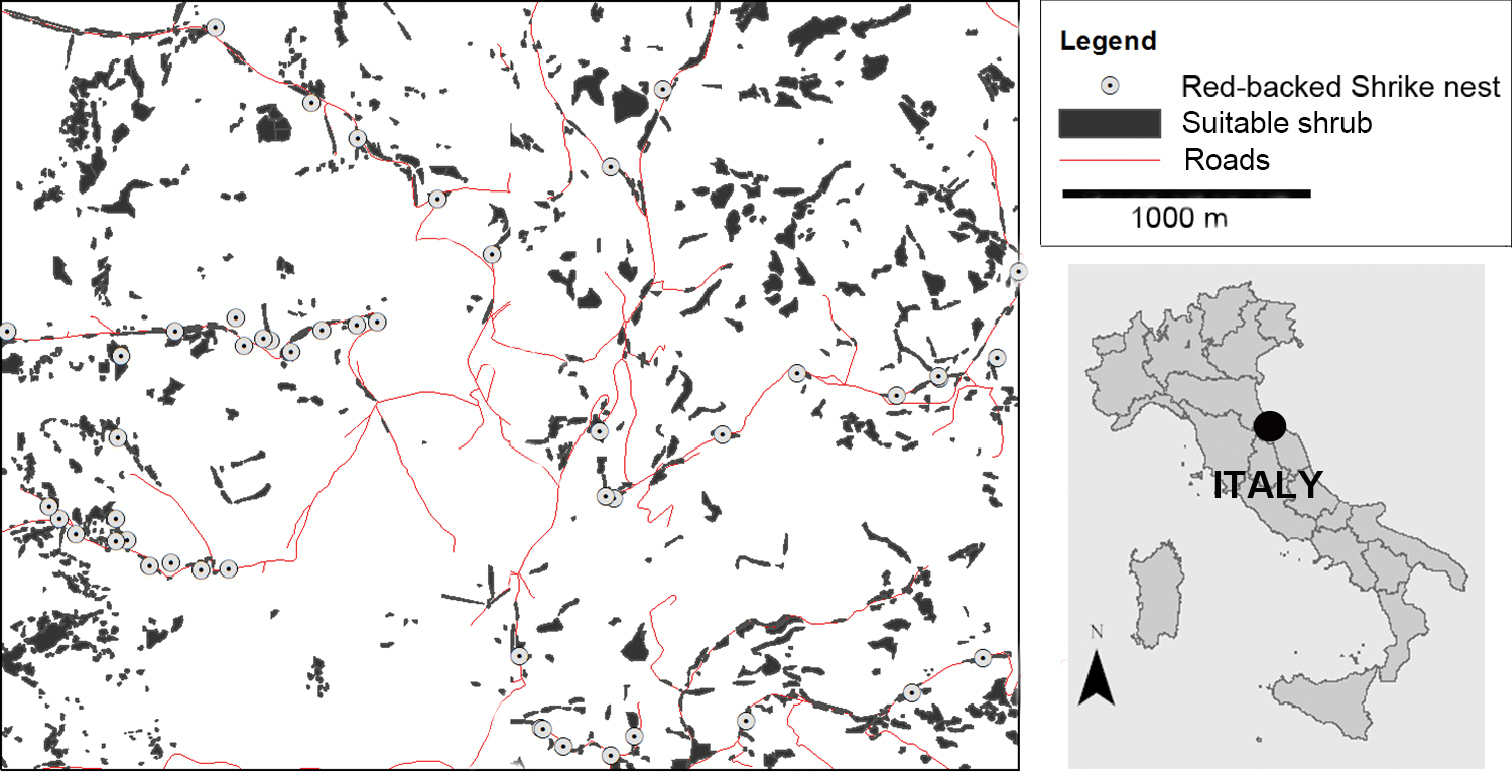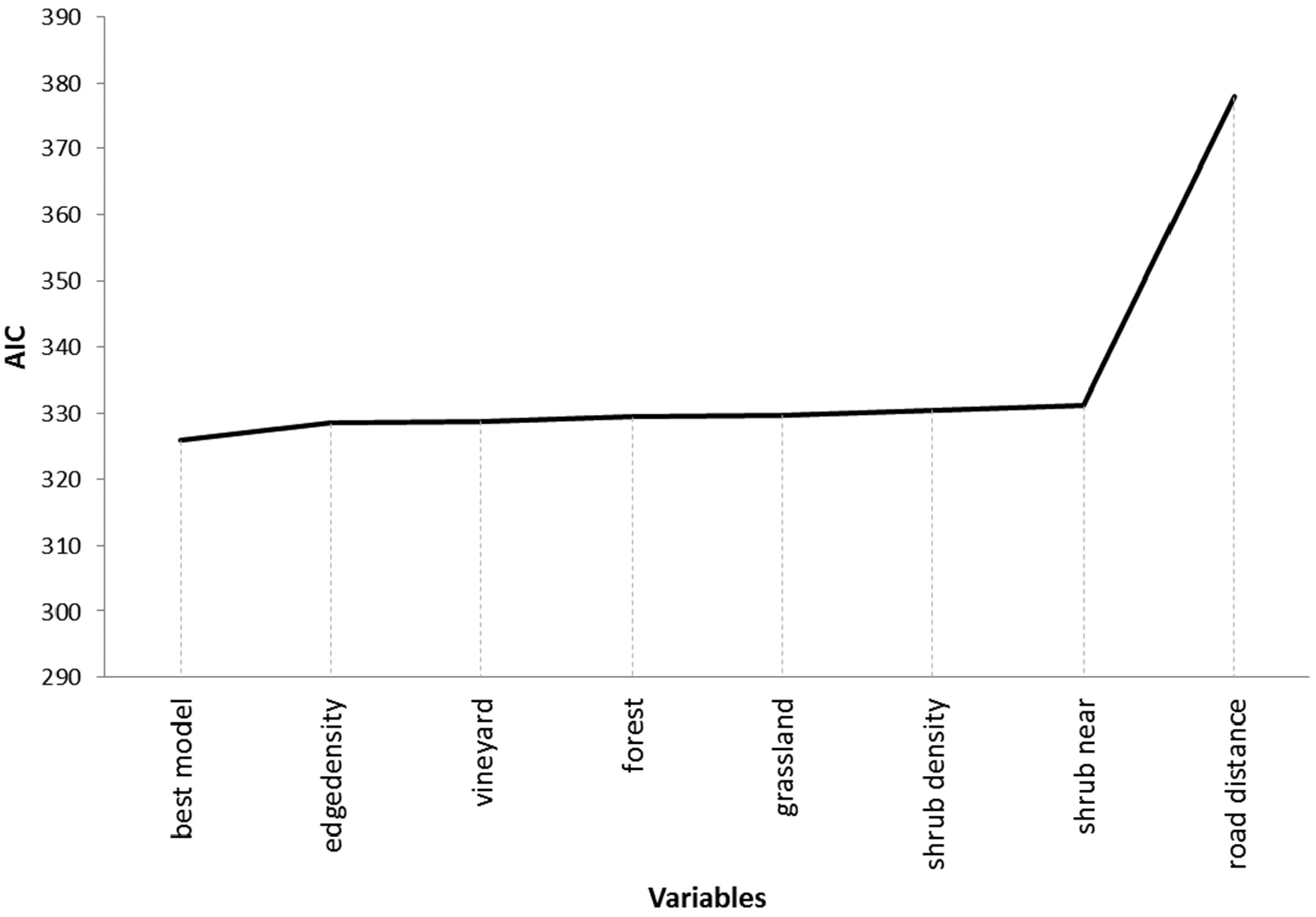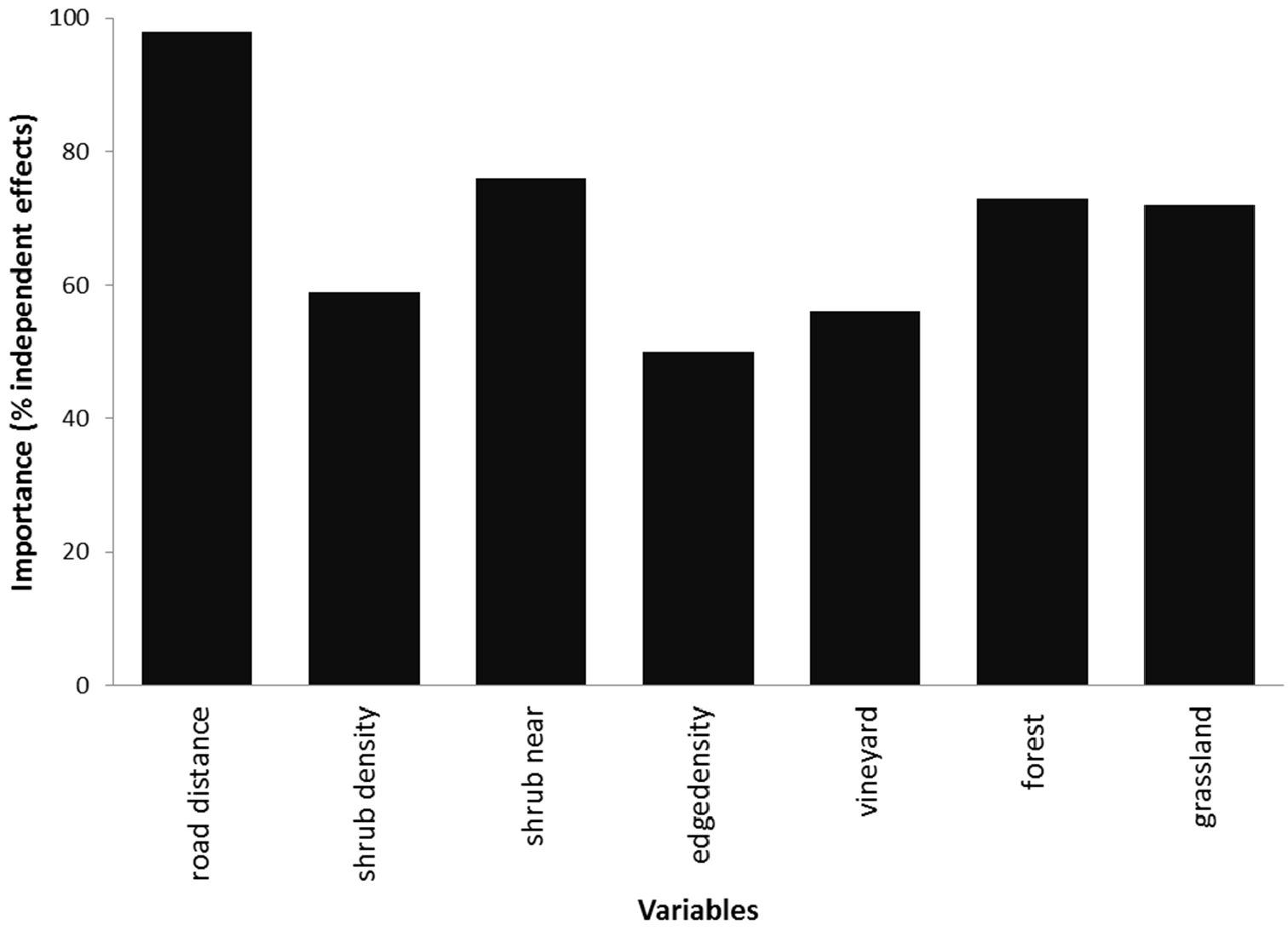






(C) 2013 Federico Morelli. This is an open access article distributed under the terms of the Creative Commons Attribution License 3.0 (CC-BY), which permits unrestricted use, distribution, and reproduction in any medium, provided the original author and source are credited.
For reference, use of the paginated PDF or printed version of this article is recommended.
Citation: Morelli F (2013) Are the nesting probabilities of the red-backed shrike related to proximity to roads? Nature Conservation 5: 1–11. doi: 10.3897/natureconservation.5.4511
Roads are a pervasive feature in the landscape, and their ecological effects on vertebrate wildlife have been well documented. The main types of effect described are mainly negative consequences on birds and other vertebrates. The major impact of roads on birds includes habitat fragmentation, traffic noise and direct mortality from road kills. However, some passerines, such as the Red-backed Shrike, seem to often use areas close to roads for nesting and hunting purposes.
The aim of this paper is to study the importance of road proximity for the selection of suitable shrubs for nesting by the Red-backed Shrike in the farmland landscapes of central Italy. To achieve this goal, the hierarchical partitioning procedures of Generalized Linear Models (GLM) are applied in order to quantify the relative effects of a number of independent variables.
At least 77% of the nests we identified were positioned less than 25 meters from roads. The mean distance from the nest to the nearest road was 12.9 ± 18.1 m. The analysis of the relative importance of each variable revealed that “road distance” is one of variables most associated with nesting probability in suitable shrubs. It is reasonable to argue that suitable shrubs and the presence of open spaces for hunting, both of which exist close to countryside roads, might represent the favourable components of the breeding habitat selections of Red-backed Shrikes. Our results can provide useful indications for census techniques and for the planning of conservation measures for the species in agricultural landscapes.
Road, Lanius collurio, occurrence, nest, suitable shrub, GLM
Roads constitute a pervasive feature in the landscape, and their ecological effects on vertebrate wildlife have been well documented (
The Red-backed Shrike is an endangered bird species whose populations have recently been in decline almost all over the world (
The aim of this work is to study if the selection of suitable shrubs for nesting by Red-backed Shrike is related to road proximity in the farmlands of central Italy.
The study was conducted in a breeding territory of the Red-backed Shrike in the River Foglia catchment area in central Italy (43°45'8.43"N, 12°37'47.10"E). The bird data was collected during the 2009 breeding season by recording the presence and occupancy for nesting of each suitable shrub in an area of 600ha. First, all of the contacts obtained within the study areas were recorded on detailed aerial photographs (scale 1:1000). Following methods used elsewhere and the census of the species in Italy (
Each shrub was digitised and classified as “suitable” according to previous ecology studies of this species in the same region (
- Suitable vegetal species: Blackthorn Prunus spinosa, Dog rose Rosa canina, Elm-leaf Blackberry Rubus ulmifolius, and Common Hawthorn Crataegus monogyna.
- Suitable plant size: minimum height of suitable shrubs (fixed empirically at a minimum of 0.5m, based on previous studies in the same area; Morelli unpublished data); and
- Suitable density of foliage: mainly the shrubs with dense foliage and a strong branch structure that is suitable for positioning and protecting the nest.
The suitable shrubs were classified as “occupied” (when a nest was found inside them) or “unoccupied”. Only active nests were included in this analysis as “occupied”.
All of the data collected was mapped by means of ArcGIS 9 tools (
Environmental parameters used to describe the study area and buffer zone around the suitable shrubs and for modelistic purposes.
| Parameter | Level or type | Details | Variable used as regressor for model procedures |
|---|---|---|---|
| Altitude | landscape | Altitude of suitable shrub (m asl) | Yes |
| Roads | landscape | Presence and type of roads (paved, unpaved, pathway) | No |
| Nearest road distance | landscape | Distance in m from suitable shrub to nearest road | Yes |
| Power lines | landscape | Presence of power lines | Yes |
| Edge-density | landscape | Sum of the perimeters of all polygons contained in the buffer zone per number of land-use typologies | Yes |
| Shrub density | landscape | Calculated in a fixed radius of 50m around each suitable shrub | Yes |
| Nearest shrub distance | landscape | Distance in m from suitable shrub to nearest shrub | Yes |
| Shrub surface | - | Surface of suitable shrub, m2 | Yes |
| Shrub shape | categorical | Classified as circle, rectangle or irregular | Yes |
| Traffic intensity | categorical | Cars/hour (classified then as low, medium, high) | No |
| Urban | land use | % | Yes |
| Forest | land use | % | Yes |
| Shrubs | land use | % | Yes |
| Uncultivated | land use | % | Yes |
| Badland | land use | % | Yes |
| Grassland | land use | % | Yes |
| Hedgerows | land use | % | Yes |
| Isolated trees | land use | % | Yes |
| Vineyards | land use | % | Yes |
| Olive | land use | % | Yes |
| Cultivated | land use | % | Yes |
The relationships between nesting on suitable shrubs and environmental parameters were examined using Generalized Linear Models (
A stepwise backward procedure was followed in order to select the most significant variables using the Akaike Information Criterion (AIC) (
In order to measure the effects of each independent variable on the occupancy of suitable shrubs, the hierarchical partitioning protocol (
The roads present in the study area were: 75% paved, 23% unpaved and 2% pathway. All of the roads were characterized by low vehicular traffic, with fewer than five cars per hour.
A total of 739 suitable shrubs were identified and mapped in the study area (Fig. 1). The density of these shrubs was 1.23 shrubs/ha, and they were mainly distributed in cultivated, uncultivated and grassland land-use typologies. Circa 34% of the total number (occupied and unoccupied) of suitable shrubs were less than 100 metres from the roads. We found 46 nests belonging to Red-backed Shrikes in the study area. All of these were located on suitable shrubs, with a density of 0.76 pairs/10 ha. There were no cases of more than one nest per shrub. The mean distance from the occupied suitable shrubs to the nearest road was 12.9m (with a maximum of 98 and a minimum of 0.2 m). In 77% of the cases, the nests were positioned less than 25m from roads (Fig. 1).
Suitable shrubs, roads and nests of the Red-backed Shrike in the study area in central Italy.
From the initial model (AUC: 0.88), which considered all of the environmental variables, was selected the best model, with a compromise between goodness of fit and model complexity (
Change in the goodness of fit of the best model when deleting each environmental variable.
Results of logistic regression for the best model related occurrence of Red-backed Shrike nests in suitable shrubs with environmental parameters in central Italy. The table shows the significant variables selected after a stepwise backward procedure using AIC criteria (p-values in bold). The AIC value of the best model was 327.9, which was the lowest figure if compared with the AIC value obtained by the initial model (336.2). AUC of best model: 83.0%.
| Parameter | Estimate | SE | Z value | p-values |
|---|---|---|---|---|
| Farmlands (n=160) | ||||
| Nearest road distance | -0.0253 | 0.0052 | -4.804 | 1.55e-06 |
| Shrub density | -0.3096 | 0.1491 | -2.077 | 0.0378 |
| Nearest shrub distance | -0.0317 | 0.0157 | -2.019 | 0.0435 |
| Edge-density | 3.2373 | 1.9718 | 1.642 | 0.1006 |
| Vineyards | 3.3881 | 1.8579 | 1.824 | 0.0682 |
| Forest | -1.2244 | 0.6812 | -1.797 | 0.0723 |
| Grasslands | 0.8670 | 0.4341 | 1.997 | 0.0458 |
| Intercept | -1.2114 | 0.5796 | -2.090 | 0.0366 |
Significance codes:
‘***’ p<0.001,
‘**’ p<0.01,
‘*’ p<0.05,
‘.’ p<0.1
However, the relative importance of each variable on the probability of the occurrence of Red-backed Shrike nests on suitable shrubs was different. The result of the hierarchical partitioning procedures highlighted the importance of road distance for the selection of suitable shrubs for nesting (Fig. 3). The relative importance of variables selected in the best model, were ranged from a maximum close to 0.98 for road distance, to a minimum of 0.51 for edge-density.
Measure of the effects of the independent variables entered in the best model, as a contribution to all of the possible models (hierarchical partitioning regression results). In the Y axis the percentage of goodness of fit for each variable.
Many studies on the breeding and feeding habitats of Lanius collurio have highlighted the importance of land use composition (
It is reasonable to argue that the presence of suitable shrubs and, at the same time, open spaces for hunting, both of which exist close to countryside roads, might represent the more favourable components for the breeding habitat selection of Red-backed Shrikes (
However, further research is needed to understand the real importance of each environmental variable in the selection of suitable shrubs by Red-backed Shrikes. This is mainly because many environmental variables could be strongly correlated, while others could be masked or hidden by other parameters (for example, the shape of the shrubs seems to be the same, whether close to or further away from the roads, but the shrubs nearest to the roads could also be pruned). Another important limitation of this work is due to the fact that only one landscape typology was sampled, meaning that the results are not really applicable to breeding habitat selection for the entire species, which is characterized by a relatively wide ecological plasticity in the choice of breeding habitat (
Furthermore, it would be important improve on our knowledge of the ecological offer of open spaces like countryside roads, which represent a low disturbance or low mortality risk to Shrikes, and may perhaps be good territory for hunting (
I would like to thank Yanina Benedetti, Maria Balsamo, Marco Dinetti, Marco Girardello and Mario D’Atri for their assistance and support with project planning. I am also grateful to ION Proofreading for the revision of the English version of this manuscript.


